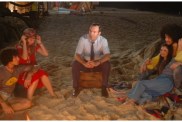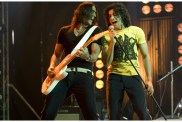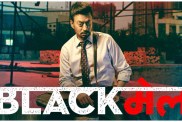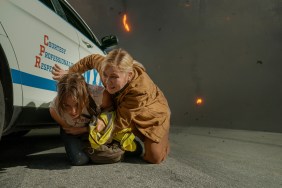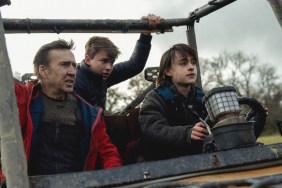
The fourth film in the “Pirates” franchise, “On Stranger Tides,” has a new director in Rob Marshall, and a slight change in tone from the previous films, with a much keener eye on history, and a clearer idea of when it takes place. Rossio considers this shift in tone to actually be very much in keeping with the franchise, “One thing that is consistent is the need for reinvention, certainly I know that Gore [Verbinski] felt that way. The second film he didn’t want to have to be like the first, and the third shouldn’t be like the second. And then we all can’t help but come into the fourth and say in this installment, what are some things that we haven’t done that stuff fit within the world? And bringing in some reading on some more actually historical references, we’ve done it before, but maybe not quite so much. So you turn up the dial on that a little bit.”
For Myhre, this accuracy helped to inform the look of the film, and distinguish it from it’s predecessors, “In the previous movies, there seemed to be quite a wide range in terms of historical accuracy, and I think they did, ‘as long as it made sense, find out what’s the most fun thing to use.’ We picked a date of 1750, we all got together in a room, and said, ‘right, let’s have a date we can pick and choose from, so we said 1750 and if it was a bit earlier, or just a hair later, maybe we’d do what was most fun for the storytelling, but we’re in that range, we’re saying mid-1700s.”
As we continue our tour, Myhre leads us out of the Storeroom, and into a small construction site. Immediately outside of the set, workmen are building pieces of a wall, Myhre apologizes, “They really, really liked the sequence in there [The Storeroom], and they’ve actually decided to add a couple beats to it because they like it so much, so we’re going to be shooting this first unit, I think again on Wednesday, and it’s put us behind on a set that we’re building.”
Not one to let the small matter of several hundred square feet of set being in the way to stop him, however, Myhre and his crew have been building the next set, a corridor in a Spanish palace, in any spare space they can find, and suspending finished pieces from the ceiling, where they will remain until the Captain’s Daughter and Storeroom sets can be dismantled and moved out of the way.
To give us an idea of how the finished set will look, Myhre produces a scale model, “I’m always big on building models to show people what the sets are going to look like, and so this is going to be a Spanish Corridor, for the Spanish King to get some information at the beginning of the movie,” he tells us, “It was inspired by The Alhambra. I want to make it look very, very, very different from anything we’re going to see in England, so we’re taking a lot of the Moorish influence on the architecture.” Even as just a scale model and a few half-built walls, the intricate work that has gone into the set is impressive.
It seems that constructing sets in one place for assembly elsewhere is a common occurrence on this shoot. In another soundstage a crew is building Postillion’s Cabin; a set that will ultimately be mounted on a gimble, enabling it to be rocked back and forth, as in the story it teeters precariously on the top of a mountain. To allow them to “get ahead of things,” Myhre explains that they are building the set on the ground, while the gimble is itself pieced together. Once the set is built, he continues, “It will all come apart and we’ll crane up the heavy pieces.”
In addition to having to build a set that could be tilted on a gimble, the crew have also been using Pinewood’s famous Underwater Stage. Here they faced another unique challenge, building sets that worked near, and even under the water. Myhre is confident they won’t have any difficulties, “It’s all been pre-built, so it’ll just be lowered It’s all going to be pre-built, pre-painted.”
At the side of the colossal water tank, is a perfect replica of the wharf we saw on the backlot. Myhre reveals, “Johnny Depp’s character and Angelica, Penelope Cruz’s character, this is part of their escape along the river Thames.”
Leaving the Underwater Stage, we walk past the studio’s exterior water tank, a structure capable of holding 806,000 gallons of water, Myhre notices it and laments, “Where Barbossa is threatening to execute pirates, trying to get information out of them, and it would be genius to be able to use this, but ‘X-Men’ is using it so we might end up just building it on the backlot, and having to create a bit of a pool with water in to make it feel like it’s the Thames.”
Once more we walk across the lot, and into another soundstage. Unlike the previous stages we have been on, this one is packed. Not only are there several vast sets inside, but a throng of people milling around, as they prepare one of them for a take. Myhre steers us into one of the sets that isn’t currently being used: an ornate courtroom.

“We wanted to find an old, 18th Century court of law, and one of the first things that we found is that there are some that are still around, that are beautiful, but they’re all filled to the brim with furniture like this, with all the walls, and dividing areas, and tables and chairs; a filming company just couldn’t film like this. We need to be able to move things around,” Myhre tells us, “So, what we’ve devised is a set that, when it’s all in, will have all of these railings and dividers and walls, but everything is going to be on wheels. It’s hard to see with the light in there, but the bottom part of the back wall comes out, and everything is on wheels and just rolls out; so we can clear one side of this in about ten minutes, and then if they need it back, we roll it back in and clear out the other side.”
Teasingly, he continues, “This will be a fun scene where Jack will meet up with some of his old friends from the previous movies.”
Next to the courtroom set is the Painted Hall, a cavernous space, based upon the real life Painted Hall at Greenwich Hospital in London. It is in this room that Jack is brought before King George II, as well as his former shipmate Barbossa. From a balcony in an off-camera area of the set, we watch as the crew prepares for a take. Extras stand patiently while veteran British character actor Richard Griffiths sits across a table from a stand in Jack Sparrow. Eventually, everybody is ready for a take, and we’re ushered out, to end up crowded around a monitor for the duration of the take.
Of course, it wouldn’t be a “Pirates” film without a suitable villain, and this time round, Jack is facing off against Blackbeard, brought to life by Ian McShane. To contrast with other pirates who appeared in the series, there was a desire to make Blackbeard more threatening, as Myhre explains.
“We wanted to make Blackbeard the scariest pirate. It was something we were saying that was interesting, there hasn’t really been a scary pirate in the ‘Pirates’ movies” he continues, “we wanted to make his ships as scary as possible. So we made the sails blood red, it almost looks like something you’d see at the bottom of a butcher shop.”
The cabin of Blackbeard’s ship reflects this. Even with much of the set dressing removed it’s an imposing space, with dark walls, complimented by skull and bone motifs throughout. At the rear is a huge stained glass window featuring a skeleton consumed by fire. Dangling from the back of the ship used for filming is a cage where Blackbeard burns his victims to death, and here a rig has been set up behind the stained glass to give the impression of a flickering fire shining through the window.
As we look around the room, Myhre tries to give us an impression of what it looked like while it was dressed, “This was filled with all of his looted treasure, from all over the world, his desk was up against the stain glassed window The whole ship had a skeletal theme to it,” his eyes then fall on a cabinet, standing against a wall, “and then this is, is a treasure cabinet where he keeps some very, very, very special treasure in.”
Myhre opens the cabinet, which is filled with ships in bottles. Once more teasing a plot point, Myhre mentions, “These are being used as a reference, as reference props for the actors, and they’ll actually all be replaced with CG ships, with magical movement inside.” Unfortunately, once more that small piece of information was all he was willing to give up.
As we walked out of the cabin of Blackbeard’s boat, Myhre drew our attention to the mast and huge red sail in front of us, as well as the railings that ran around the edge of the deck. Much like the door to The Captain’s Daughter, these were actually used on the ship, and then brought over from Hawaii for the sake of continuity. As Myhre explains though, they wouldn’t be staying in England long.
“We’re going to have to get all this stuff back to Hawaii because Disney’s doing a resort hotel. They’re going to keep the ship up there. So all this stuff, like a week or two after we’re done shooting is sent back.”
This is a strange turn of events for Myhre, a man who has been on the “Pirates of the Caribbean” ride every year since he was five, and who was bitterly disappointed to miss out on working on the first three Pirates of the Caribbean movies, to have something he’s designed be a part of that mythos. He sums it up rather eloquently though, “I have the best job in the world, I get to build pirate ships.”
